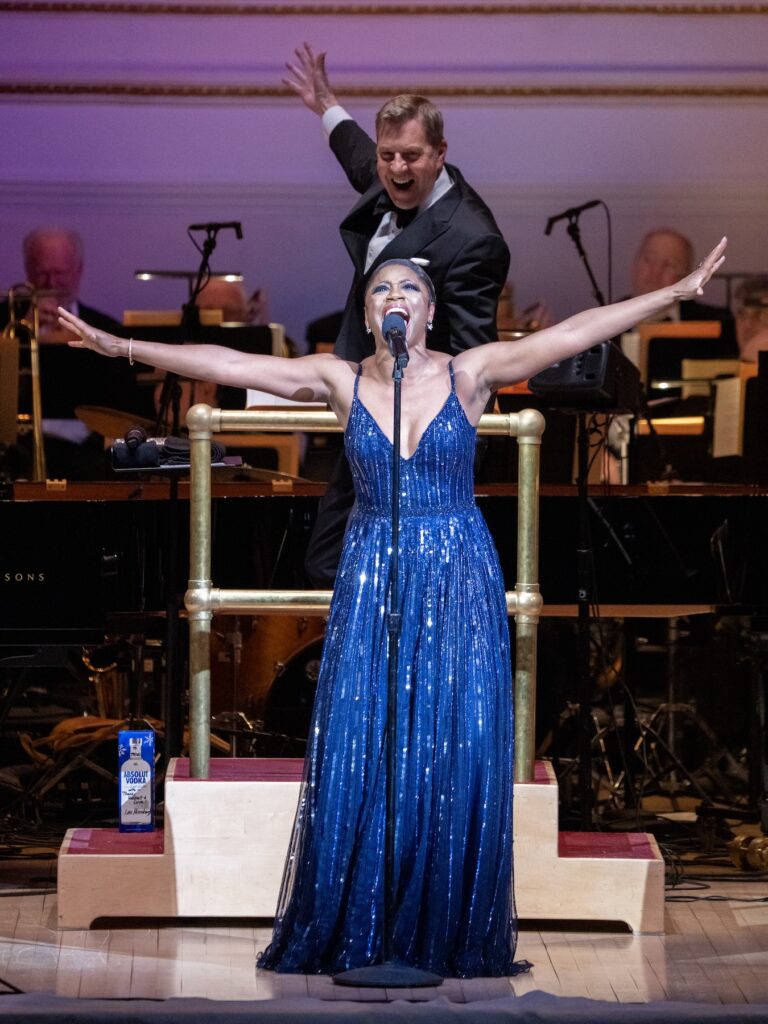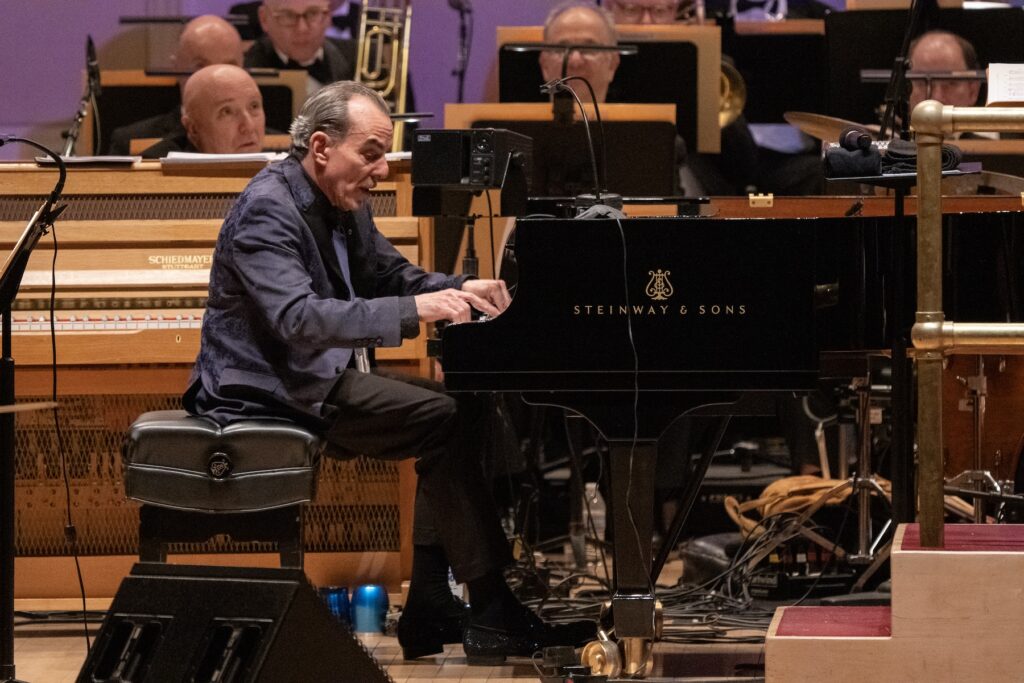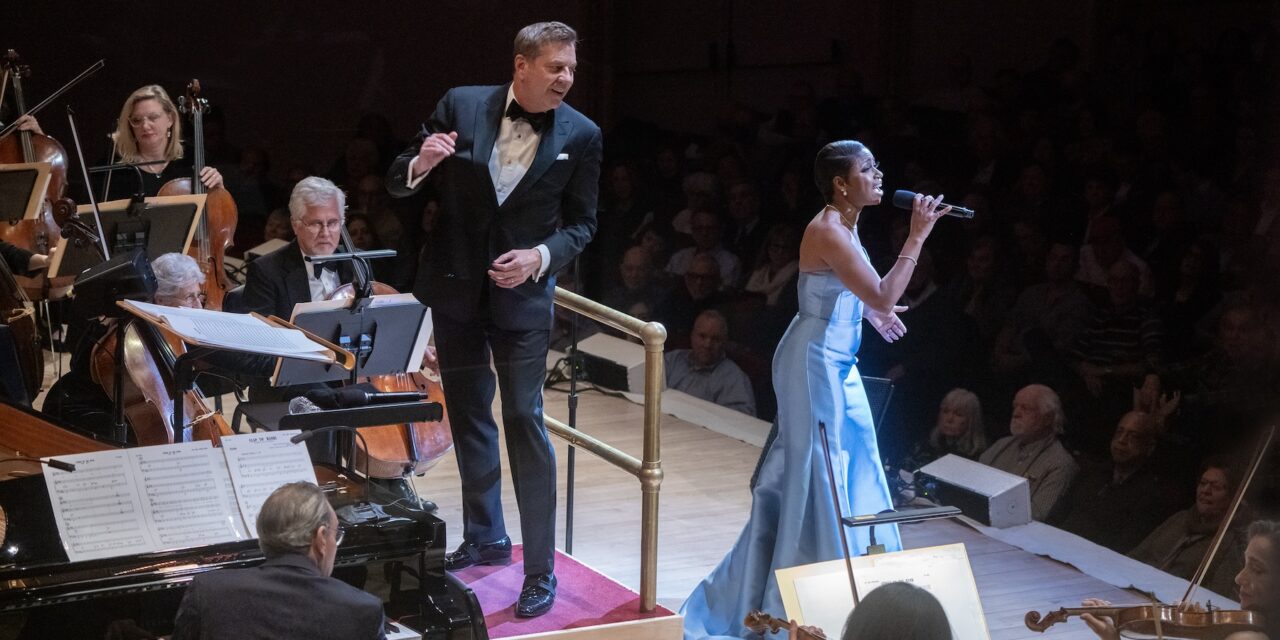Music Review by Marilyn Lester . . . .
On February 9, 2024, it was easy to imagine being transported back in time to February 12, 1924 when George Gershwin’s now iconic “Rhapsody in Blue” premiered at Aeolian Hall, not far from where the Carnegie Hall, Stern Auditorium/Perelman Stage sits now. Then it was famed band leader Paul Whiteman (who commissioned the piece) bearing the baton, with Gershwin at the piano. Fast forward to Steven Reineke, Music Director and Conductor of the New York Pops leading the orchestra, with Lee Musiker on the keys. And in both cases, when the “Rhapsody” played its last note, the audience went wild with applause and an extended standing ovation. To say that in our time, the air was electric would be a gross understatement.

The Pops always puts on a good show, but this one, Jazz, Love, and Gershwin: A Century of Rhapsody in Blue, under the baton of the ever-charismatic Reineke, was extra special. Because of the musical focus of the evening, it was a chance for the Pops to stretch out, play more band numbers than usual, and to feature a single guest artist, Montego Glover. This Broadway chanteuse proved ideal in interpreting the timeless work of the genius brothers, George and Ira Gershwin, whose legacy together began precociously on Tin Pan Alley before the First World War and ended with George’s tragic death from a brain tumor in July, 1937. He was only 38 years old. Reaching back into history, there are two more icons that came into play for this concert. In the mid 1950s, jazz singer Ella Fitzgerald, whom Duke Ellington declared was “beyond category,” began recording her Songbook series, largely arranged by Nelson Riddle. The two worked on the 1959 epic Ella Fitzgerald Sings the George and Ira Gershwin Song Book. Glover, who knows how to use and direct a fulsome voice with range and a syrupy vocal tone, plus superb phrasing and dynamics, sang several tunes with Riddle arrangements.




The first of these was the title song of the Broadway show, “Strike Up the Band,” complete with the orchestra intro of the leader’s whistle signaling the start: “Hey leader, strike up the band” goes the lyric. And because the Pops was leaning heavily into jazz mode, and also following the leader, this arrangement featured a marching band staple for time-keeping, the venerable tuba. Happily, and authentically, several of Glover’s numbers included the verse, so often cut in modern arrangements. This was the case for “They Can’t Take That Away from Me” and a swinging “I Got Rhythm” in which Glover tried out some scat. Throughout the concert she was a powerful, upbeat stage presence, whose chemistry with friend and leader Reineke was a joy to experience. Audience-aware, she early on addressed the patrons in the seats with thanks and an observation of “you look delicious.” Her knock-your-socks-off number came with the finale, an arrangement of “Summertime” by Tom Ranier that contained a stirring brass feature. Glover moved from operatic to jazzy to sultry bluesy, with a very high wow-factor.
The Pops set the pace for their band numbers with an opening of the overture from Crazy for You, arranged by William David Bronn. The fast-paced numbers contained therein were a veritable catalog of Gershwin big hits—all very familiar within the Songbook canon. Opening the second act of the evening was the whimsical “Promenade” aka “Walking the Dog” from the 1937 Fred Astaire/Ginger Rogers film, Shall We Dance—full of musical onomatopoeia. Act one closer was a product of George Gershwin as a “serious” composer. A melodist at heart, his non-songbook work was jazz-adjacent and informed by studies of “classical” artists such as Maurice Ravel. This number, “Cuban Overture” was written on his return from a two-week holiday in Havana. The polyrhythms include rumba and clave themes, and a strong tilt to dance. The tune is a fiesta of Caribbean cultural influences, brought to life here by the Pops.


The main feature of the evening, “Rhapsody in Blue,” followed the “Cuban Overture.” It was sublime and was preceded by a smidgen of back story from Reineke. Paul Whiteman, a hugely popular leader fronted a dance band that tilted toward jazz but also drew from classical influences, perfect for Gershwin, who wrote it for solo piano and orchestra. Following Gershwin’s example, polymath Lee Musiker was full of creative improvisational ideas as the Pops, from clarinet trill to last note, followed the written score. (Musiker, a well-named musical genius, sat in on most of the evening’s offerings, living up to his own reputation of a massively talented figure across genres in the music world.) And so the Rhapsody proceeded, through large-scale harmonic and melodic structure over two main themes and several sub-themes. Ironically in the century past, musicologists have been analyzing and often tearing the Rhapsody apart. Even the great Leonard Bernstein, who admittedly loved the work, was compelled to jump into the fray and call it out as “not a real composition.” No matter, “Rhapsody in Blue,” a time-honored favorite, has stood the test of time. At its thrilling conclusion by the Pops, an audience as one stood up and applauded without letup.


The encore by Glover and the New York Pops orchestra was a bittersweet one: George Gershwin’s final composition, “Love Is Here to Stay,” completed before his death and destined for the 1938 film The Goldwyn Follies. Ira Gershwin’s lyrics, written after George’s death became a tribute to his brother. The tune became a sing-a-long with the audience on its feet yet again—a united body of concert-goers certifying that the New York Pops had risen to another new height of performance excellence.
Photos: Richard Termine


















